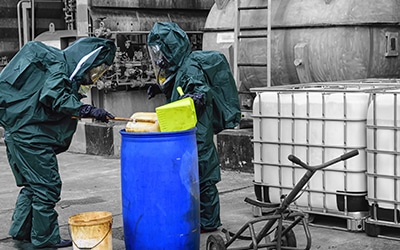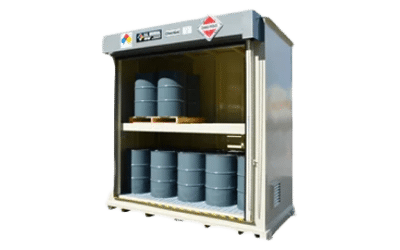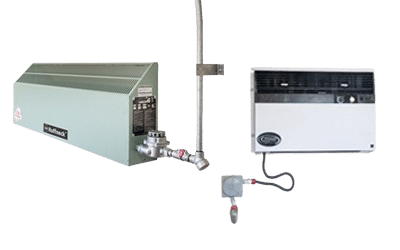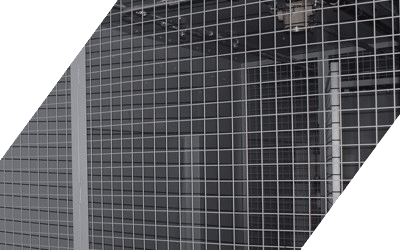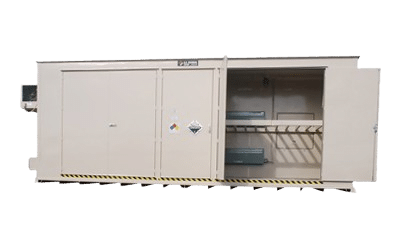Hazardous Material Storage Buildings
Making sure your hazardous material is safe and secure is easy with our hazardous material storage buildings. U.S. Chemical Storage offers customizable hazardous material storage buildings that can be manufactured to meet EPA, NFPA, IBC, IFC regulations and FM approvals or Warnock Hersey standards.
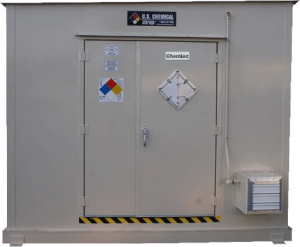
Both fire-rated and non-fire-rated construction is available. A hazardous material (hazmat) is any substance or agent that can cause harm to individuals, animals or the environment or any item that can cause a health hazard or physical hazard.
Hazmat can be in liquid, solid, or gas form. Materials with the hazmat label can be everyday products like paint to more dangerous items like acids. There are nine separate classes of hazardous materials. U.S. Chemical Storage hazmat storage buildings and lockers offer maximum protection. All buildings are constructed with a leak-proof secondary containment sump to prevent environmental contamination in the event of a spill.
Types of Hazardous Material Storage Buildings
Hazmat storage buildings offer safety for people, investments and the environment. Buildings approved for general hazmat storage are made of durable, non-reactive materials. In addition to safe construction practices, buildings approved for hazardous material storage also include ventilation, drainage, and the ability to separate materials from one another.
All U.S. Chemical Storage buildings come with a 15-year structural warranty and built-in secondary spill containment sump. Customize your building with a range of optional parts and accessories to meet specific storage requirements.
Household Hazardous Waste
To protect the environment from pollution, the EPA restricts certain household hazardous items from going to landfills. These items include paints, cleaners, oils, batteries, pesticides and more. Many municipalities help communities dispose of these commonly used hazardous items by providing household hazardous waste disposal. Because there are so many types of household hazardous waste, safely combining and segregating the various chemicals that come from the general public is a necessity.
Household hazardous waste buildings are one of our most used structures. U.S. Chemical Storage buildings for household hazardous waste typically have three or more rooms separated by partition walls. This allows storage of incompatible materials in different compartments. All buildings are completely customizable and feature built-in secondary containment. Modular configurations are available for a larger storage footprint.
Hazardous Waste Storage in the Military
Exposure to hazardous waste and other chemicals is an occupational hazard, even in the military. Hazardous material storage buildings from U.S. Chemical Storage reduce the risk of this occupational hazard, allowing military personnel to focus on the mission at hand. All prefabricated storage buildings comply with current legislation but can cost significantly less than standard construction buildings.
Features & Benefits
- 100% customizable
- Durable steel construction ensures structural integrity
- EPA compliant containment sump
- Mixing and dispensing rooms available
- 15-year structural warranty
- Acrylic alkyd enamel with an epoxy paint upgrade available
- Modular solutions available for larger footprints
Frequently Asked Questions
The definition of a “sump” is a pit or reservoir providing containment for spilled liquids. U.S. Chemical Storage offers leak-proof spill containment sumps in each standard model. All our sumps are tested for leaks for a 24-hour period prior to finishing. The sump is then covered by a steel or fiberglass floor grating and can even be equipped with a resistant plastic sump liner to protect against corrosive chemical accidental spills. The size of the sump is dictated by code based on the volume of liquid being stored within the building.
Building size is determined by the amount of hazardous material you are planning to store, the need for occupancy or inspection around these materials, and must take into consideration the most efficient way of moving these materials into and out of your chemical storage building.
Start by speaking with one of our experienced Technical Sales Engineers to learn about the needs of your application. They will want to know what type of chemicals you are storing? How much of it will you be storing? What proximity to other buildings, people, egress paths, or environmental features will it need to be? Do you require special spill containment?
And from there they’ll ask any related questions that determine additional options; Material Handling – Climate Control – Ventilation – Occupancy – Lights – Sensors – Alarms – Door Styles – Eyewash Stations and other requirements are not uncommon. Answers to these questions will dictate the building’s fire rating construction as well as anything else you’ll need for proper code compliance.
Chemical storage buildings manufactured by U.S. Chemical Storage are designed to get your operation compliant. Contact one of our technical sales engineers to learn how we can find the best solution for your compliance needs.
You will also want to learn more about specific chemical storage requirements in your specific area by contacting your local “Authority Having Jurisdiction” (AHJ) who could be a local fire marshal, a municipal code official, or a city environmental department.
Request a Quote
RELATED PRODUCTS
ChemLoc™ Chemical Storage Buildings
For unparalleled protection, use non fire-rated hazardous chemical storage buildings for storing flammable or combustible chemicals at least 30 feet from other buildings. These chemical storage units have countless applications and accessories that can be custom engineered to fit your specific needs. View Product >Climate Control Options for Your Storage Building
U.S. Chemical Storage offers a full line of climate control chemical storage building options to store chemicals within their distinct favorable temperature range. View Product >Partition
Walls
Segregating chemicals with partition walls allows for the storage of multiple chemicals inside the same chemical storage building.
View Product > Racks
and Shelves
Let U.S. Chemical Storage help you get organized with a full line of storage racks and shelves to keep your chemicals sorted.
View Product > 
YOUR PARTNER IN THE PROCESS. EXPERIENCE YOU CAN TRUST.
We deliver the precise building solution with the speed, security, and high quality that you demand.

